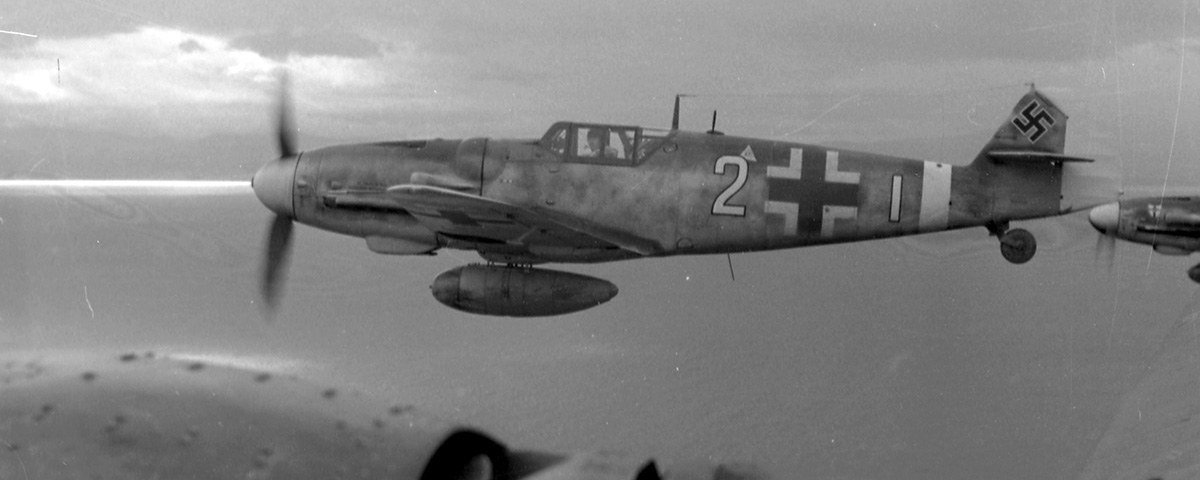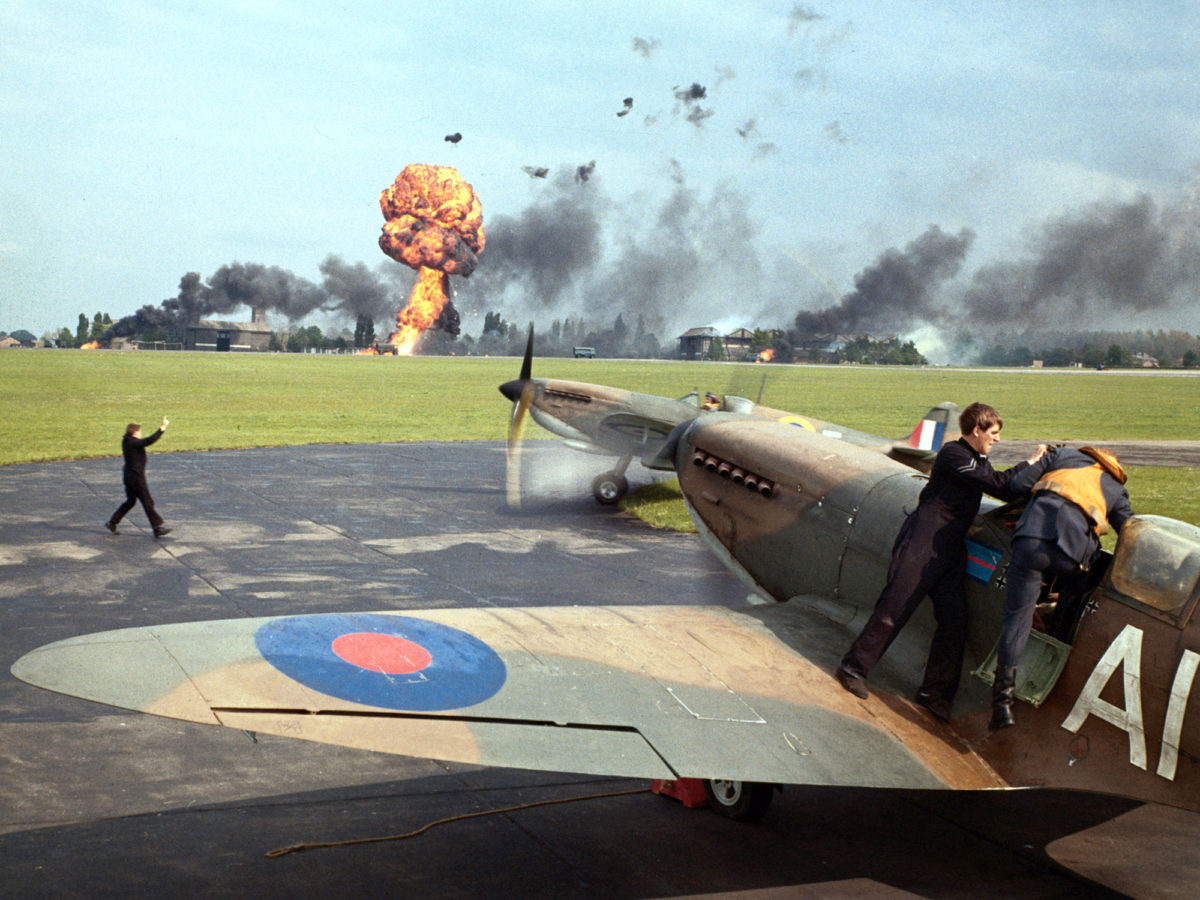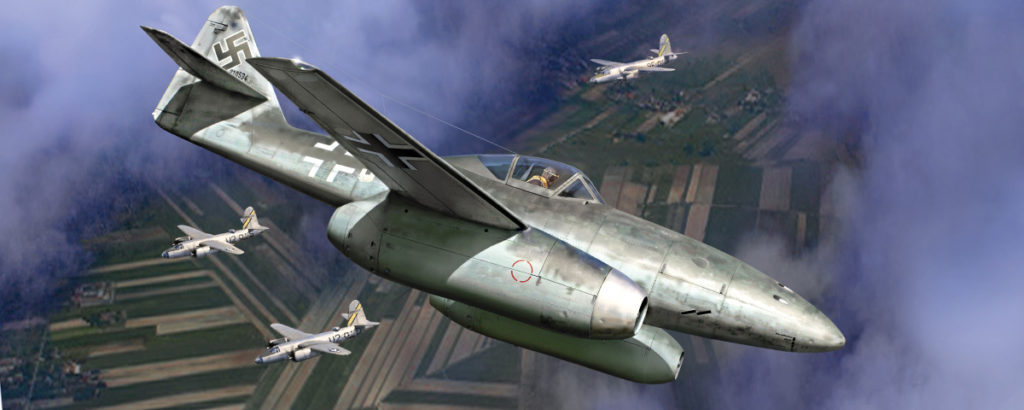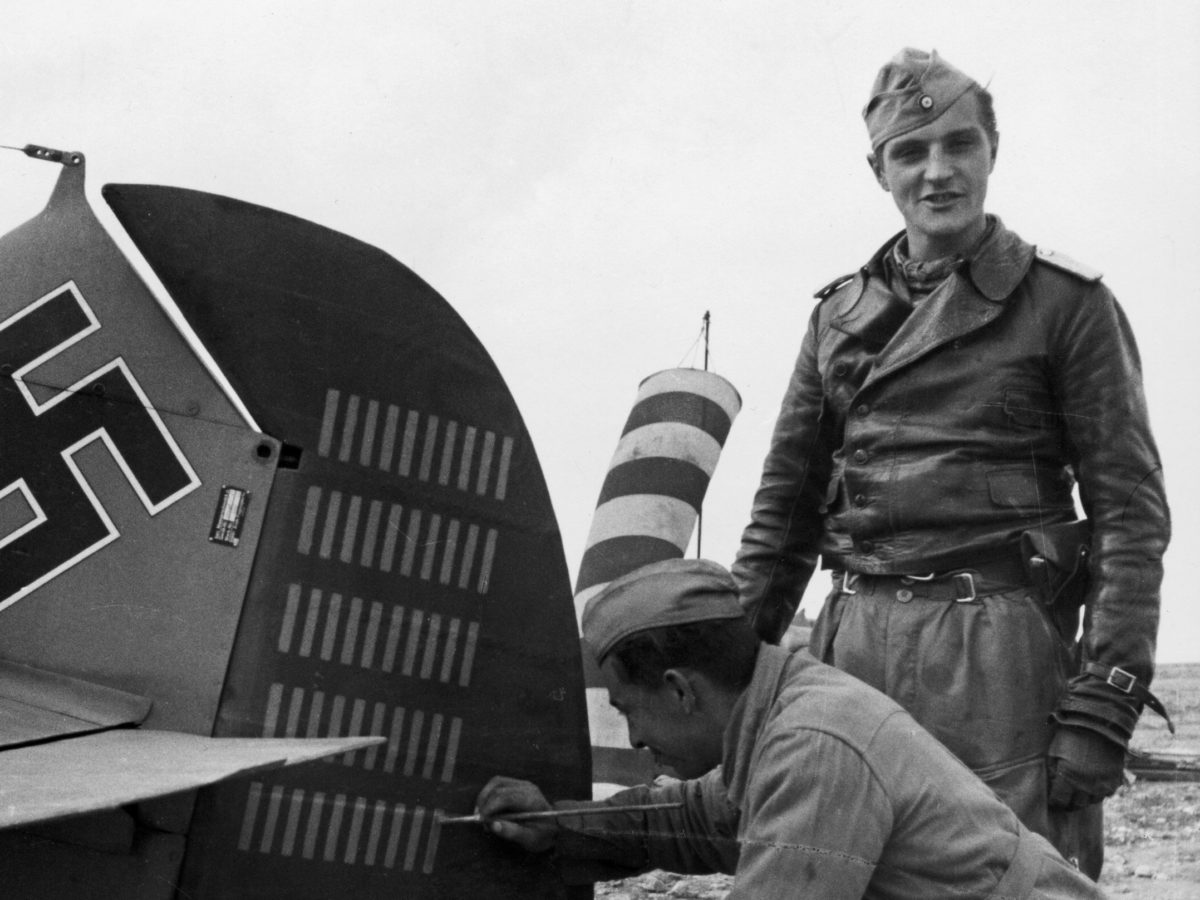Few arguments are more futile–yet more perennially enticing–than the question of which was the greatest fighter of World War II. What criterion does one use to define “great?” Performance? Versatility? Combat record? Don’t ask veteran fighter pilots to settle the matter. They have their own opinions, best expressed by the late Soviet ace of aces Ivan Kozhedub’s answer to the question: “The La-7. I hope you understand why.” The Lavochkin La-7 was indisputably a great fighter. More important, it was his fighter.
One mark of a great fighter was the loyalty it earned from its pilots, and aircraft such as the Hawker Hurricane, Grumman F6F Hellcat, Lockheed P-38 Lightning, Republic P-47 Thunderbolt, North American P-51 Mustang, Yakovlev Yak-3 and Mitsubishi A6M Zero still have their die-hard partisans. Aviation enthusiasts’ attachment to some planes, like the Supermarine Spitfire, transcends loyalty and can best be described as outright affection.
To that list must inevitably be added the Messerschmitt Me-109. Perhaps it was not the best performer of the war, and even its pilots would admit that it was not the safest or most comfortable plane to fly. But its combat record, from beginning to end, was monumental, and it was the weapon of choice for the greatest fighter pilots in history. Comparing the Me-109G with the Brewster B-239 that he had flown previously, Finnish ace of aces Eino Ilmari Juutilainen said that “while the Brewster was a gentleman’s airplane, the Messerschmitt was a killing machine.”
That impression was echoed by Eric Brown, a Royal Navy pilot who test-flew an Me-109G in 1944: “The Bf-109 always brought to my mind the adjective ‘sinister.’ It has been suggested that it evinced the characteristics of the nation that conceived it, and to me it always looked lethal from any angle, on the ground or in the air; once I had climbed into its claustrophobic cockpit, it felt lethal!”
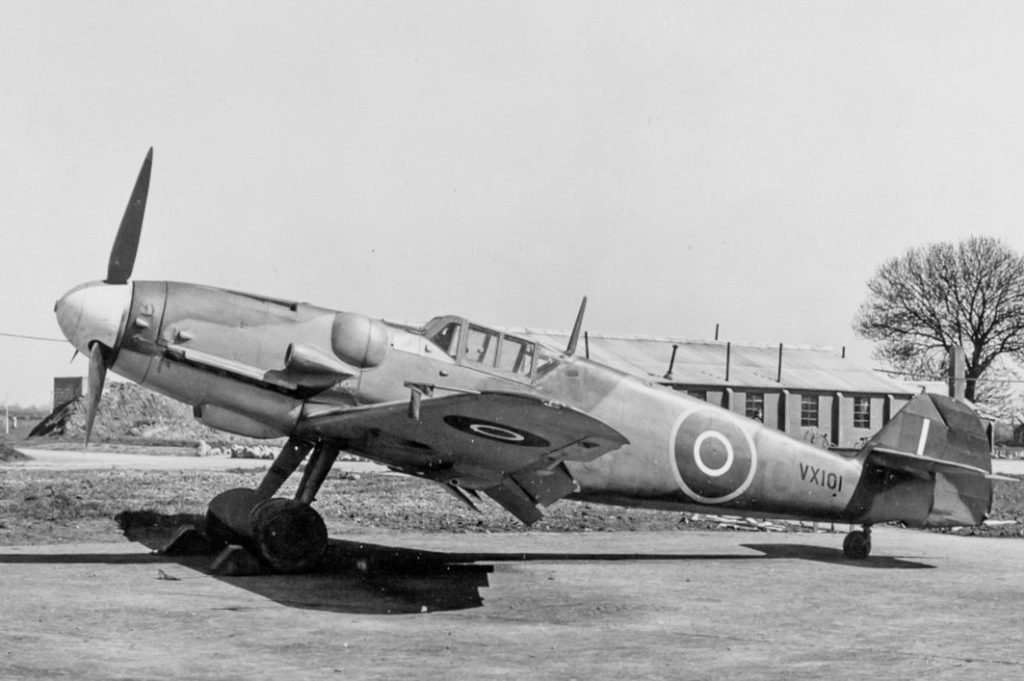
Anyone who flew the Me-109, and anyone who faced it in battle, would be inclined to agree. The P-47 inspired awe. The Zero earned loyalty. The Spitfire gained devotion. The Me-109 commanded respect.
The man behind the machine, Wilhelm Emil Messerschmitt, was born on June 26, 1898, in Frankfurt-am-Main, the son of a wine merchant. By 1931, he was co-manager of the Bayerische Flugzeugwerke Allgemeine Gesellschaft (BFW), which underwent bankruptcy proceedings on June 1 of that year. BFW was eventually revived on May 1, 1933, but by then one of Messerschmitt’s chief detractors, Erhard Milch, had become the newly empowered Nazi Party’s undersecretary of aviation.
In mid-1933, Messerschmitt began work on a four-passenger light transport of cantilever low-wing monoplane design, with retractable landing gear. Completed in the spring of 1934, the BFW M.37, later redesignated Bf-108 Taifun (“typhoon”), was entered in the fourth Challenge de Tourisme Internationale. Although the Bf-108 did not win any of the events, its performance was impressive, and it earned a production contract.
Even before the Bf-108 had made its first flight, Messerschmitt learned that the RLM (Reichsluftfahrtministerium, or air ministry) was about to issue a specification for a fighter, to be powered by the Junkers Jumo 210 engine and to be capable of at least 280 mph. Officially, most German airplane manufacturers were invited to submit designs; unofficially, only the established firms like Arado, Heinkel, Fieseler and Focke Wulf could expect serious consideration. Milch did not even inform BFW of the competition, but unknown to him, his superior, Aviation Minister Hermann Göring, had forwarded a confidential message to Messerschmitt, asking him to develop “a lighting-fast courier plane which needs only to be a single-seater.” It was obvious to Messerschmitt that Göring was actually alluding to a fighter.
Messerschmitt and the design team at BFW’s Augsburg factory–principally Robert Lusser, Richard Bauer and Hubert Bauer–set about incorporating the Bf-108’s features into a low-wing monoplane fighter with retractable landing gear, an enclosed cockpit, leading-edge slots and trailing-edge flaps in the wings. While work proceeded on the Versuchs (prototype) Bf-109 fighter, Germany officially established the Luftwaffe on March 1, 1935, and Adolf Hitler publicly renounced the Treaty of Versailles restrictions on German rearmament on March 16.
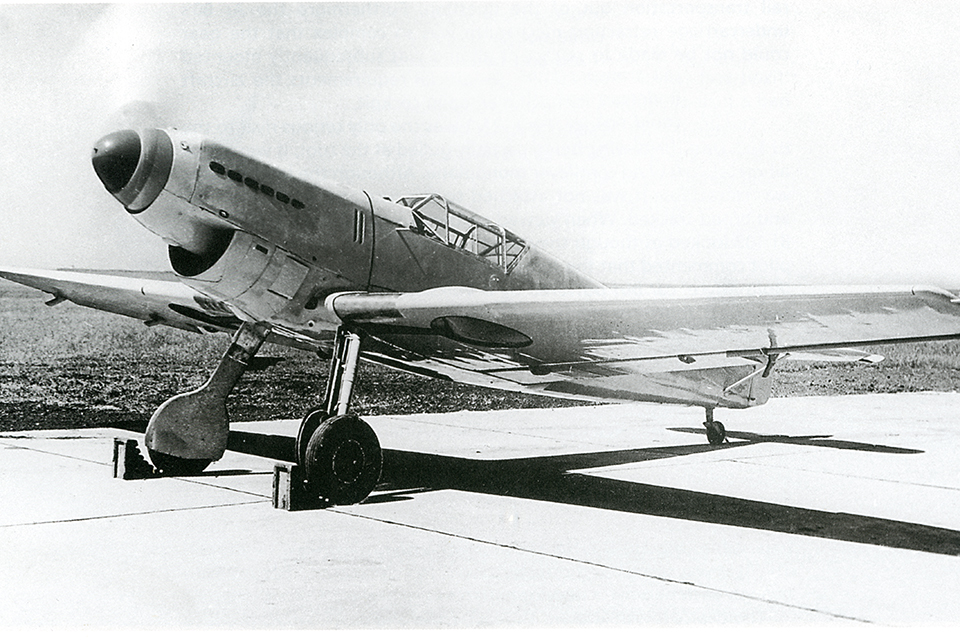
The prototype Bf-109V-1 was completed in August 1935, and evaluation flights began at the RLM’s test center at Rechlin, initially using a 675-hp Rolls-Royce Kestrel engine in place of the Jumo. The Bf-109V-2, completed in October, introduced the 610-hp Jumo 210A as well as a strengthened undercarriage, and the Bf-109V-3, delivered in June 1936, was the first to be armed with an engine-mounted 7.92mm MG 17 machine gun.
In spite of its high wing loading, which limited its maneuverability at low speeds, the Bf-109 yielded such outstanding performance that the RLM quickly eliminated the Arado Ar-80 and Focke Wulf Fw-159 from consideration. That left only the Heinkel He-112 as a possible competitor. Ten preproduction Bf-109B-0s were ordered, but then two events occurred that would affect the Bf-109’s fate.
June 1936 saw the issuance by Britain’s Royal Air Force of production contracts for 600 Hawker Hurricane fighters and 310 Supermarine Spitfires. The latter, first flown on March 5, had characteristics similar to the Bf-109V-1’s. The potential threat posed by those new British fighters added urgency to Germany’s fighter development efforts, and armament on the Bf-109V-4, introduced in November, was increased to three MG 17s.
The other pivotal event was the revolt of Spain’s conservative elements under General Francisco Franco y Bahamonde against the Republican government, followed by the dispatch of German aircraft to Franco’s aid, all of which occurred in July 1936. The following November, eager Luftwaffe volunteers were formed into the Condor Legion to fight for Franco’s Nationalists. By then the Soviet Union had sent aircraft and pilots to aid the Spanish Republic, including the Polikarpov I-15 biplane and the I-16, the world’s first low-wing monoplane fighter with retractable landing gear and an enclosed canopy. To the Germans’ alarm, both Soviet fighters completely outclassed their Heinkel He-51 biplanes. In consequence, the Germans rushed the Bf-109V-4 to Spain in December, to be followed by Bf-109B-1s (aka “Berthas”), the first of which left the production line in February 1937. Spain would provide a combat environment in which to refine the Bf-109 as a fighter–and the tactics to use it to best effect.
The first operational unit in Spain, 2. Staffel of Jagdgruppe 88 (2.J/88) under Oberleutnant Günther Lützow, began receiving its new fighters in March. Operations were initially plagued by accidents, but its pilots soon overcame the challenge of taking off and landing on a narrow-track undercarriage in an airplane that tended to drop its left wing, by applying plenty of compensation with the rudder. Once they had overcome the Bf-109B’s eccentricities, they commenced operations over the Brunete salient on July 10, 1937.
The Bf-109B and its principal rival, the I-16, were at first closely matched. The Bf-109B was faster in level flight and in a dive, while the I-16 had a superior climb rate and maneuverability. Republican ace and fighter squadron leader Andres Garcia Lacalle commented in his memoirs that the I-16 was superior to the Messerschmitt up to 3,000 meters (9,840 feet), but from that altitude upward, the Bf-109B’s performance achieved complete mastery over that of the I-16.
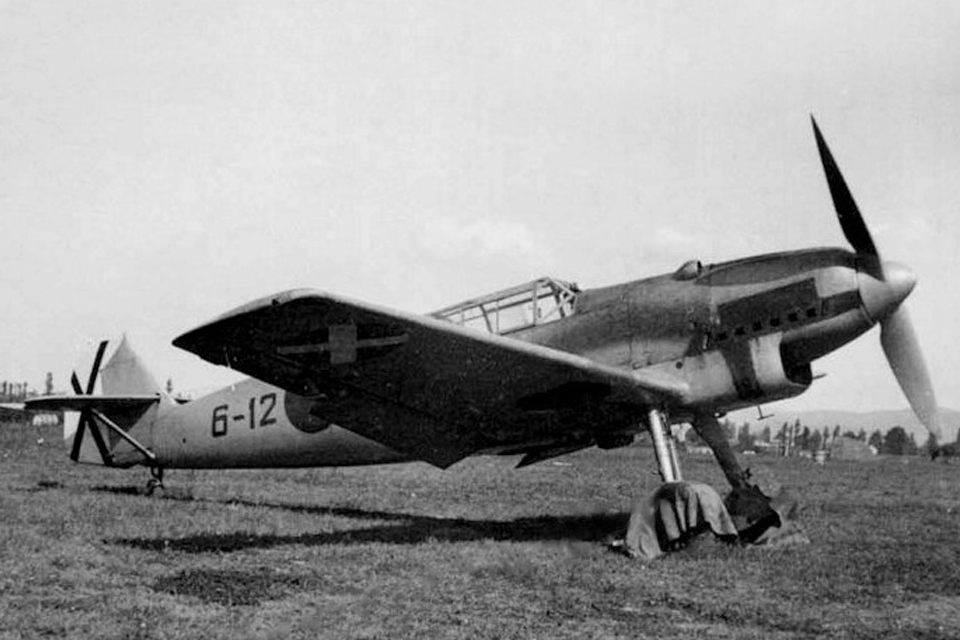
The Messerschmitt drew first blood in the air on July 8, when Leutnant Rolf Pingel and Unteroffizier Guido Höness were credited with two Tupolev SB-2 bombers, although the Republicans attributed only one of those two losses to a Bf-109, the other having fallen victim to a Fiat C.R.32. A series of air battles fought on July 12 resulted in the downing of two Aero A-101s by Höness, an SB-2 by Pingel and three I-16s by Pingel, Feldwebel Peter Boddem and Feldwebel Adolf Buhl. Höness was shot down and killed while attacking another SB-2 that same day–the first of thousands of Messerschmitt pilots to die in combat.
During the second Ebro campaign, between July and October 1938, Oberleutnant Werner Mölders of 3.J/88 developed a significant fighter tactic. By combining two Rotte, the basic two-man elements within a Staffel, into a loose but mutually supportive team, he created an infinitely flexible offensive and defensive unit that he called the Vierfingerschwarm (“four-finger formation”). That fundamental concept would become the basis for numerous variations. Mölders himself was the leading ace of the Condor Legion, with 14 victories, and on July 15, 1941, he became the first fighter pilot to pass the 100-kill mark. When he died in a transport plane crash on November 22, 1941, his score stood at 115.
While the Bf-109 was being blooded over Spain, its capabilities were also being demonstrated to the world in Switzerland. At the Fourth International Flying Meeting, held at Zürich in July and August 1937, Bf-109Bs won four first prizes. Back in Germany, the Bf-109V-13, using a boosted 1,650-hp version of the Daimler-Benz DB 601 engine and flown by Hermann Wurster, set a landplane speed record of 379.8 mph on November 11. Ernst Heinkel, whose He-112 was rapidly losing ground to the Messerschmitt, responded with a sleeker design, the He-100. With German fighter-inspector Ernst Udet at the controls, an He-100V-3 achieved a speed of 394.4 mph on June 6, 1938, and an He-100V-8, flown by Hans Dieterle, reached 463.92 mph on March 30, 1939.
Not to be outdone, Messerschmitt undertook a major redesign of his basic fighter, producing the Me-209V-1, with a special DB 601ARJ engine that could boost its power from 1,500 hp to 2,300 hp for about one minute, bringing the maximum speed up to 469.22 mph on April 29. At that point the Bf-109 was in full production, and the Nazi Propaganda Ministry falsely designated the record-making plane the “Bf-109R” (to make it seem like a less-radical variant on an existing fighter type), while the RLM barred Heinkel from trying to outdo the Messerschmitt. As a result, that official piston-engine speed record would stand for the next 30 years.
Guided by lessons learned in Spain, Messerschmitt produced a rapid succession of improved fighters. The Bf-109C-1 (“Clara”), with a fuel-injected Jumo 210Ga engine and four machine guns, arrived in Spain in the spring of 1938, followed by the Bf-109C-2, with a fifth machine gun mounted in the engine. The Bf-109D (“Dora”), five of which joined 3./J88 in August, combined the Bf-109C-1’s four-gun armament with the Bf-109B-1’s carburetor-equipped Jumo 210Da engine. Meanwhile, Messerschmitt’s experiments with the fuel-injected Daimler-Benz DB 600 and DB 601 engines, which were hampered by cooling problems, ultimately resulted in burying two radiators in the plane’s wings, leaving only an oil cooler under the fuselage. In addition, the DB 601A-powered Bf-109V-14’s armament increased to two MG 17 machine guns in the nose and two 20mm MG FF cannons in the wings, along with a three-bladed controllable-pitch VDM airscrew. The result was put into production in early 1939 as the Me-109E-1, soon to be nicknamed “Emil” by its pilots.
The fighter’s revised designation, which has caused confusion and controversy among aviation historians for decades, reflected the complete acquisition of BFW stock by Willy Messerschmitt in late 1938. According to the Luftwaffe’s own historical records, the old “Bf” reference was retained for the Bf-108, the Bf-109B through D, and the Bf-110A and B Zerstörer twin-engine fighters. All other Messerschmitt products, starting with the Me-109E and Me-110C, officially used the “Me” prefix, although the issue would continue to be confused in the years to come by the appearance of the “Bf” prefix on stamped plates on various Me-109 components as late as 1945.
Soon after the Me-109E-1 entered production, Messerschmitt designed a naval version with an extended wingspan, a strengthened airframe and an arrestor hook. Designated the Me-109T (for Träger, or carrier), it was intended for use aboard the aircraft carrier Graf Zeppelin. The project was dropped when construction on Graf Zeppelin was halted in 1940, but some production Me-109T-1s and a fighter-bomber variant, the Me-109T-2, saw operational use with land-based units up to the summer of 1942.
The Luftwaffe had 946 operational Me-109s when Germany invaded Poland on September 1, 1939. In addition, some 300 Me-109Es were exported to Switzerland, Yugoslavia, Romania and Spain between April 1939 and April 1940. Three Me-109E-3s were also shipped to Japan for evaluation early in 1941. The Japanese soon abandoned the idea of producing Emils under license, but the Allies took the possibility seriously enough to give the “Japanese Me-109” the code name “Mike.”
Two of the export orders were to cause some embarrassment later. In May 1940, three Heinkel He-111s that had strayed into Swiss airspace were shot down by Swiss-flown Me-109Es. Reichsmarschall Hermann Göring reacted by deliberately sending France-bound bomber formations over Switzerland with an escort of Me-110s. The clashes that ensued resulted in the loss of seven more German and three Swiss aircraft, after which Göring prudently relented. When the Germans invaded Yugoslavia in April 1941, the Luftwaffe again had to deal with opposition from its own Me-109Es, fiercely flown by Yugoslav pilots.
The Emil spearheaded German air offensives against Denmark, Norway, Belgium, the Netherlands and France in 1940, overwhelming such opponents as the Fokker D.XXI, Morane-Saulnier MS.406 and Hawker Hurricane. The German Experten (aces with 10 or more victories) finally met their match over Dunkirk in May 1940, when they first encountered the Supermarine Spitfire. The rivalry between those two classic fighters would continue throughout the Battle of Britain. The Messerschmitt had the advantage in high-altitude performance, as well as in the ability of its fuel-injected engine to function even while inverted, when a Spitfire’s Rolls-Royce Merlin power plant would be starved for fuel. The Spitfire’s lower wing loading endowed it with superior maneuverability, but the Messerschmitt’s principal disadvantage lay in its limited range. After 20 to 30 minutes over the average British target, a Messerschmitt pilot would have to break off his engagement or he would run out of fuel before he could return to base across the English Channel.

Even before the Me-109Es commenced their ultimately unsuccessful struggle for aerial mastery over Britain, work had begun on a new, aerodynamically refined model in the spring of 1940. One Me-109E was fitted with a 1,300-hp DB 601E-1 engine in a new symmetrical cowling, with the supercharger air intake set farther back to increase the ram effect. A larger, rounded spinner was fitted to the propeller, shallower radiators with boundary layer bypasses were incorporated under the wing and a cantilever tail plane replaced the strut-braced version. After being test-flown on July 10, 1940, the new type was further refined by the addition of new wings with rounded tips, a smaller rudder and a fully retractable tail wheel.
Designated the Me-109F-0, the new Messerschmitt was tested late in 1940 and accepted. The production Me-109F-1, powered by a 1,200-hp DB 601N, with an engine-mounted 20mm MG FF cannon and two cowl-mounted 7.9mm MG 17 machine guns, began to reach operational units in January 1941. The Me-109F-2 version of “Franz,” as its pilots called it, replaced the MG FF with a higher velocity 15mm MG 151 cannon, while the Me-109F-3 returned to the DB 601E engine in early 1942.
Franz appeared as the Spitfire Mk.V was getting the better of the Me-109E in the cross-Channel duels that followed the Battle of Britain, and re-established ascendancy over the British fighter, especially at high altitudes. Me-109F-4/Bs, equipped with fuselage racks for a single 551-pound SC 250 bomb, frequently darted across the Channel on hit-and-run Jagdbomber, or “Jabo,” missions. In the first year of the German invasion of the Soviet Union, the veteran Me-109E and Me-109F pilots ran up astronomical scores against the outdated I-16s, as well as newer Lavochkin-Gorbunov-Gudkov LaGG-3s and Yakovlev Yak-1s flown by less experienced Soviet pilots. Me-109F-4/Trop variants, with tropical filters to guard their engines against sand and dust, took an equally heavy toll on British aircraft over North Africa and the Mediterranean. Among the desert Messerschmitt pilots of Jagdgeschwader 27 “Afrika” was the top-scoring German ace in the West, Hans-Joachim Marseille, who piled up 158 victories, including 17 in one day, before his death on September 30, 1942.
Recommended for you
The next improvement in the series involved the introduction of the 1,475-hp DB 605A engine in the Me-109G-1, which entered service in the late summer of 1942. The first “Gustav,” as the G model was nicknamed, had a basic armament of one 20mm MG 151 cannon and two 7.9mm MG 17 machine guns, but the Me-109G-5 introduced two 13mm MG 131 machine guns in place of the MG 17s. The cowlings of that and subsequent Me-109G models required enlarged fairings over the breechlocks and ammunition feeds that earned them the alternate sobriquet of Beule (“bump”).
The Me-109G was the most numerous of the Messerschmitts, with production reaching 725 a month by July 1943, and that year’s total reaching 6,418 aircraft. In spite of Allied bombing raids against German industry, Me-109 production for 1944 reached 14,212. In addition to the Messerschmitts produced in Germany, Hungary built about 700 Me-109Gs under license at Budapest and Györ until September 1944. Romania also began licensed production in the IAR plant at Brasov, but completed only 16 Me-109G-6s and assembled 30 others from German-delivered components before its facilities were destroyed by bombers of the U.S. Fifteenth Air Force on May 6, 1944.
Neutral Switzerland acquired 12 Me-109G-6s as part of a deal for destroying an Me-110G-4/R7 equipped with the latest Liechtenstein SN-2 radar and oblique-firing Schräge-Musik 20mm cannons, after the night fighter had accidentally landed at spy-infested Dübendorf on April 28, 1944. The Gustavs, and two other Me-109Gs that were interned after straying into Swiss airspace, were assigned to Fliegerkompagnie 7, but they were unreliable due to deteriorating German production standards at that point in the war, and saw little use.
Although somewhat past its prime as a first-line fighter, the Me-109G remained a foe to be reckoned with right to the end of the fighting, due in part to its fuel-injected DB 605A engine, but primarily due to the expertise and ingenuity of its pilots. The Gustavs were flown at one time or another by all the greatest aces of the Axis powers, including Finland’s Eino Ilmari Juutilainen (94 victories), Alexandru Serbanescu of Romania (45), Mato Dukovac of Croatia (40), Dezsö Szent-Györgyi of Hungary (32), Ján Reznak of Slovakia (32), Stoyan Stoyanov of Bulgaria (6) and Spanish volunteer Gonzalo Hevia Alvarez Quiñones (12). A squadron of anti-Stalinist Russians who had allied themselves with the Germans was also equipped with Me-109E-1s; several of its pilots scored 15 or more victories, and one, Leonidas Maximciuc, claimed 52. Some Italian aces added to their scores flying Me-109Gs in 1943 and 1945. The only noteworthy Axis aces who did not put in some flying hours in Me-109s were Japanese.
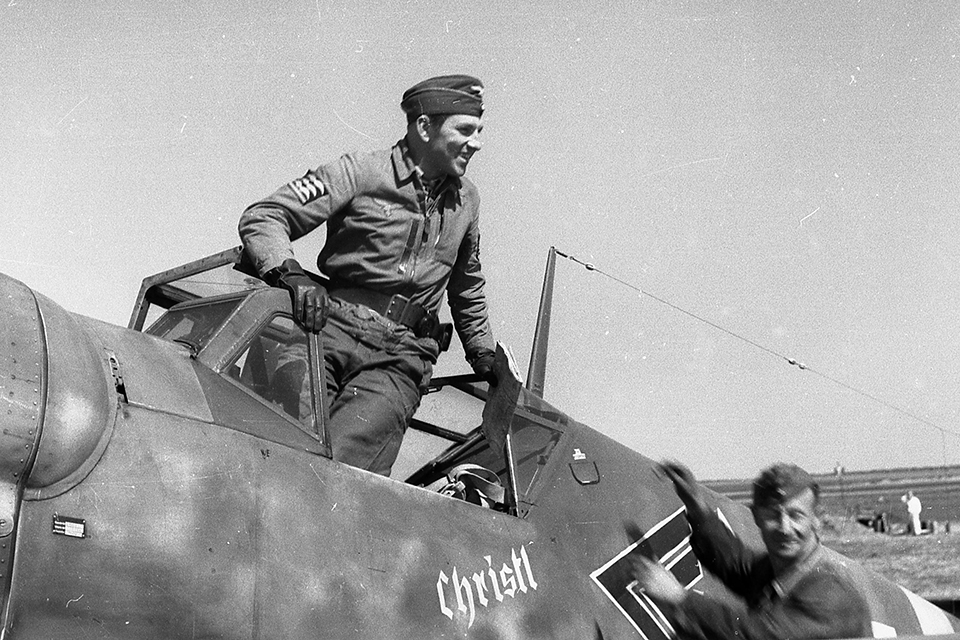
Leading them all, of course, were the Germans themselves. The all-time ace of aces, Erich Hartmann, scored all of his 352 victories in the Me-109, preferring to stay with it rather than take the time to familiarize himself with more advanced types. Gerhard Barkhorn, the Luftwaffe’s second-ranking ace with 301 victories, considered the Me-109F his favorite fighter. Günther Rall, the third-ranking German ace with 275 victories, flew all variants of the Me-109 from E to K, as well as putting in a brief stint in the Focke Wulf Fw-109D. Rall echoed Hartmann’s sentiments: “I liked the 109 most because I was familiar with it.”
Not everyone who flew the Me-109 liked it. Walter Nowotny, the leading Austrian ace, scored his first successes in Me-109Es but soon moved on to the Fw-190A, in which he gained most of his 258 victories. For every German who preferred the familiarity of the Me-109 there was another who was happier flying the Fw-190, the Me-262 jet or anything else.
By mid-1943, the Allies were fielding a new generation of fighters equal or superior to the Me-109G, such as the Spitfire Mk.IX and XIV, P-51B Mustang, P-47D Thunderbolt and Yak-9D. British Captain Eric Brown said that the captured Me-109G-6/U2 he test-flew in 1944 was “delightful to fly” at its cruising speed of 240 mph, but in a 400-mph dive, “the controls felt as though they had seized!” On the whole, he concluded that “providing the Gustav was kept where it was meant to be (i.e., above 25,000 feet/7,620 meters), it performed efficiently both in dogfighting and as an attacker of bomber formations.”
Even when outclassed, the Messerschmitt could surprise its adversaries. Thomas L. Hayes, Jr., a P-51 ace of the 357th Fighter Group with 8 1/2 victories, recalled diving after a fleeing Me-109G until both aircraft neared the sound barrier and their controls locked. Both pilots took measures to slow down, but to Hayes’ astonishment, the Me-109 was the first to pull out of its dive. As he belatedly regained control of his Mustang, Hayes was grateful that the German pilot chose to quit while he was ahead and fly home instead of taking advantage of Hayes’ momentary helplessness. Hayes also stated that while he saw several Fw-190s stall and even crash during dogfights, he never saw an Me-109 go out of control.
Allied pilots who had the opportunity to sit in the Me-109’s cockpit claimed it to be so narrow that they could barely work the control column between their knees. “The windscreen supports were slender and did not produce serious blind spots,” said Eric Brown, “but space was so confined that movement of the head was difficult for even a pilot of my limited stature.” The British and their American colleagues were also appalled at its minimal instrumentation. Soviet ace Vitali I. Popkov, who scored 41 victories in LaGG-3s and La-5FNs, flew a captured Me-109 and, like his Western colleagues, came away amazed that its pilots had been able to perform as well as they did.
It has been said, however, that where you sit is where you stand, and German Me-109 pilots saw things from a decidedly different perspective. Franz Stigler, a 28-victory Experte, test-flew captured American fighters and commented: “I didn’t like the Thunderbolt. It was too big. The cockpit was immense and unfamiliar. After so many hours in the snug confines of the [Me-109], everything felt out of reach and too far away from the pilot. Although the P-51 was a fine airplane to fly…it too was disconcerting. With all those levers, controls and switches in the cockpit, I’m surprised [American] pilots could find the time to fight.”
As the war turned against Germany, Me-109Gs carried a variety of armament to counter the growing armadas of Allied bombers. One such weapon was the 210mm Nebelwerfer 42 rocket, two of which were mounted in Wfr.Gr.21 Dodel launchers under the wings of Me-109G-6/R2 Pulk Zerstörer (“formation destroyers”). Although inaccurate, the rockets were capable of throwing bomber groups into disarray. The Germans added two 20mm MG 151 cannons in Rüstsatz 6 underwing-mounted gondolas on the Me-109G-6/R6, and 30mm MG 108s on the Me-109G-6/U4. Although devastating against American bombers, the Kanonenboote (“gunboats”), as their pilots called them, were unable to outmaneuver or outrun the Allied fighter escorts.
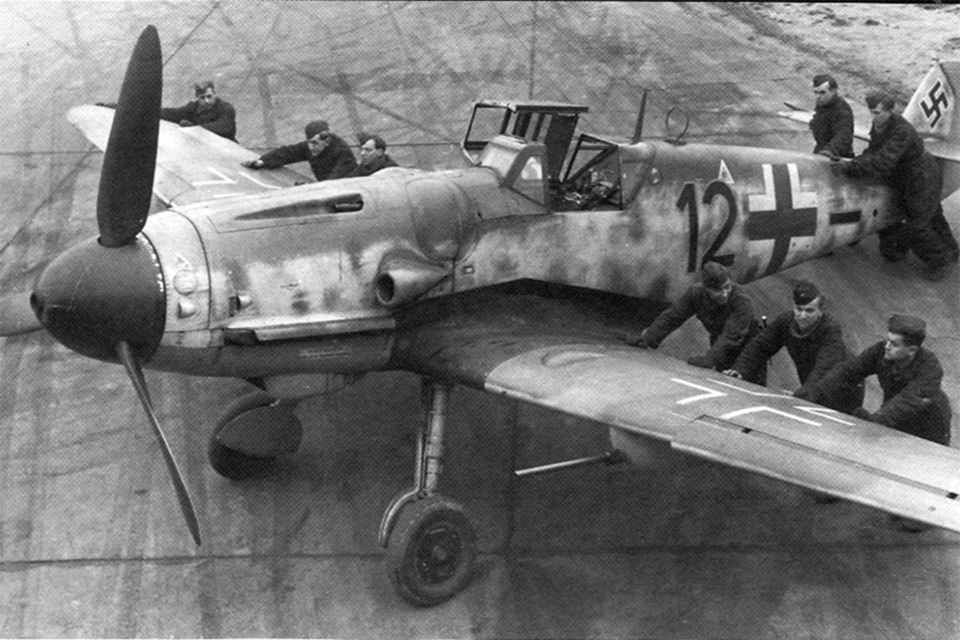
In 1943, JG.1’s Me-109G pilots began dropping 551-pound bombs on American bomber formations in hopes of dispersing them. The Me-109G-6/N, equipped with a variety of navigation equipment, including an FuG 350 Naxos Z receiver in a small glass dome aft of the cockpit for homing in on the H2S radar of RAF Pathfinders, was briefly employed by JG.300 early in 1944 for lone Wilde Sau (“wild pig”) attacks on British bombers at night. A spate of landing accidents at night and in bad weather led to the abandonment of the night-fighting Gustavs. In the Mistel (“mistletoe”) project, Me-109Fs and Fw-190As were mounted on the backs of unmanned Ju-88s packed with explosives. When they neared a target, the manned fighters would separate from the Ju-88s, and the pilots would guide the flying bombs to the targets by radio.
In the fall of 1944, a series of boosted DB 605 engines gave the Me-109 another new lease on life. The DB 605D featured a GM1 nitrous oxide injection system, while the DB 605ASM, ASB, ASC, DB and DC variants had MW 50 methanol injection systems that briefly boosted its power from 1,550 to 2,000 hp. The engines were installed in the Me-109G-6AS, G-10 and G-14. The Me-106G-10, which also eliminated the Beule by covering the machine-gun breechlocks under a more carefully streamlined cowling, was the fastest of the Gustavs, with a speed of 428 mph at 25,000 feet.
Late-model Me-109G-6s, G-10s and G-14s featured a new, taller, unbalanced wooden tail and rudder assembly, as well as a modified canopy offering better pilot visibility, known as the Galland hood. Training versions of the Me-109 were considered as early as 1940, but serious work on such an airplane did not begin until 1942, resulting in the Me-109G-12, essentially a lengthened, two-seat conversion from Me-109G-1, G-5 and G-6 fighters. A twin of a different and more literal sort was the Me-109Z Zwilling, a pair of Me-109Fs joined by a central wing and tail plane extension, with the right cockpit faired over to carry extra fuel. A production version, based on the Me-109G, would have carried five 30mm MG 108 cannons or up to 1,102 pounds of bombs. The Me-109Z prototype was completed in 1943 but was damaged in an Allied air attack before it could be flight tested. The project was dropped in 1944, before the prototype could be repaired, but by a curious coincidence, the Zwilling concept was successfully applied by the Americans to their North American P-51, leading to the development of the P-82 Twin Mustang in April 1945.
A small number of Me-109H-0 and Me-109H-1 high-altitude interceptors, featuring an enlarged wingspan of 39 feet 1 1/4 inches and a DB 601E-1 engine with GM 1 power boost, were tested in the spring of 1944. The H model could reach an altitude of 47,000 feet but displayed serious flutter in dives, and development was canceled in favor of the Focke Wulf Ta-152. There was no Me-109I, and the Me-109J was a proposed Spanish version to be licensed out to Hispano-Suiza. The experimental Me-109L was to use a 1,750-hp Junkers Jumo 201E engine. The Me-109S would have featured blown flaps to improve its low-speed handling characteristics. The Me-109TL project envisioned jet power, but so many modifications were necessary that it was dropped in favor of the Me-262A.
The final production wartime variant was the Me-109K, powered by a 1,550-hp DB 605 ASCM/DCM engine with MW 50 methanol injection. Standard armament consisted of one engine-mounted 30mm MK 103 or MK 108 cannon and two 15mm MG 151 cannons in the cowling. Its maximum speed reached 452 mph at 19,685 feet. The Me-109K-2 and Me-109K-4 made their combat debuts during Operation Bodenplatte, a last desperate mass Jabo strike against British and American air bases in France on January 1, 1945. By then, they were too few and too late to have any more effect on the war’s outcome than the more advanced fighters that had been developed by a desperate Nazi war machine.
May 8, 1945, marked the end of Hitler’s Reich but, curiously, not the end of the Me-109 story. Between 1939 and 1945, 45 Bf-109Bs, 15 Me-109Es, 10 Me-109Fs and 25 Me-109Gs were delivered to Spain. After the war, Hispano Aviación installed 1,300-hp Hispano Suiza 12-Z-89 engines in the Me-109G airframes, the first of which, designated the HA-1109JIL, debuted on March 2, 1945. The company subsequently produced its own version of the Messerschmitt, powered by a Hispano-Suiza 122-17 engine. The HA-1109-KIL first flew in March 1951, and 200 were eventually built. A two-seat trainer version, the HA-1110-KIL, was added in October 1953, and the HA-1112-KIL had a combination of two wing-mounted cannons and underwing rockets. A final version, the HA-1112-MIL Buchon (“Pigeon”), used a 1,400-hp Rolls-Royce Merlin 500/45 engine driving a Rotol four-bladed propeller. Ironically, the Spanish-built Me-109, which used the same engine as its old enemy, the Spitfire, represented its German forebear in the 1969 film The Battle of Britain.
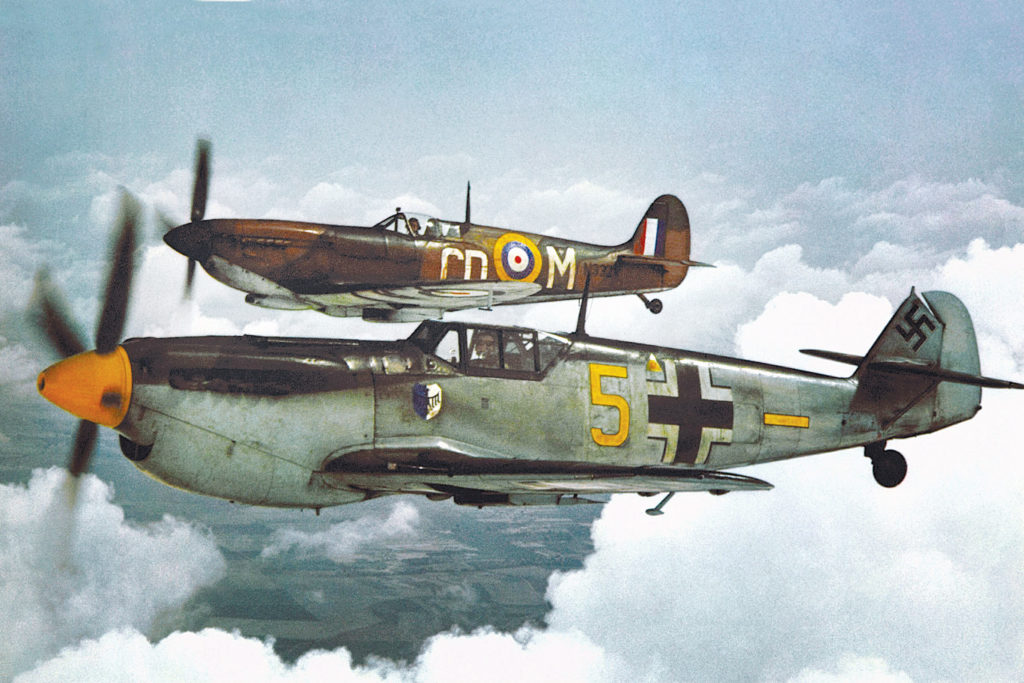
The story of the Czechoslovakian-built version of the Messerschmitt involves yet another twist of fate. The Avia factory at Prague-Cakovice was to have built the Me-109G-14 under license but had not begun production before the fall of the Reich. With the resurrection of the Czechoslovakian Republic, Avia proceeded with production of that same design, calling it the C-10, along with a two-seat trainer, the C-110, which were respectively designated S-99 and CS-99 by the Czechoslovakian air force.
As supplies of DB 605 engines dried up, Avia was compelled to use another German engine that it was already producing, the 1,350-hp Junkers Jumo 211F, thus reverting to the Me-109’s original power plant. Unfortunately, the Jumo 211F was heavier, yet less powerful, than the DB 605. Using a broad, paddle-bladed propeller, the C-210 displayed mediocre performance in the air, but its takeoff and landing characteristics were positively vicious. Pressed into military service as the S-199 fighter and CS-199 trainer, the Jumo-engine Avia became known as the Mezec (“mule”) to its unhappy pilots, although it served with the Czech National Security Guard until as late as 1957.
In 1948, with the Jews of Palestine about to declare statehood in the face of their hostile Arab neighbors, the Czechoslovakians found an outlet for their unloved Mezecs. Ignoring the United Nations-mandated embargo on arms to the Middle East, Czechoslovakia made a deal in early April to sell 10 S-199s to the Jews at the exorbitant rate of $44,600 per fighter, plus $6,890 for equipment, $120,229 for ammunition and a $10,000 ferrying charge. By the time Israel’s statehood was declared on May 14, a mixed bag of foreign volunteers and indigenous Jews, the latter including Mordechai “Modi” Allon and Ezer Weizmann, were hastily striving to master the new fighter.
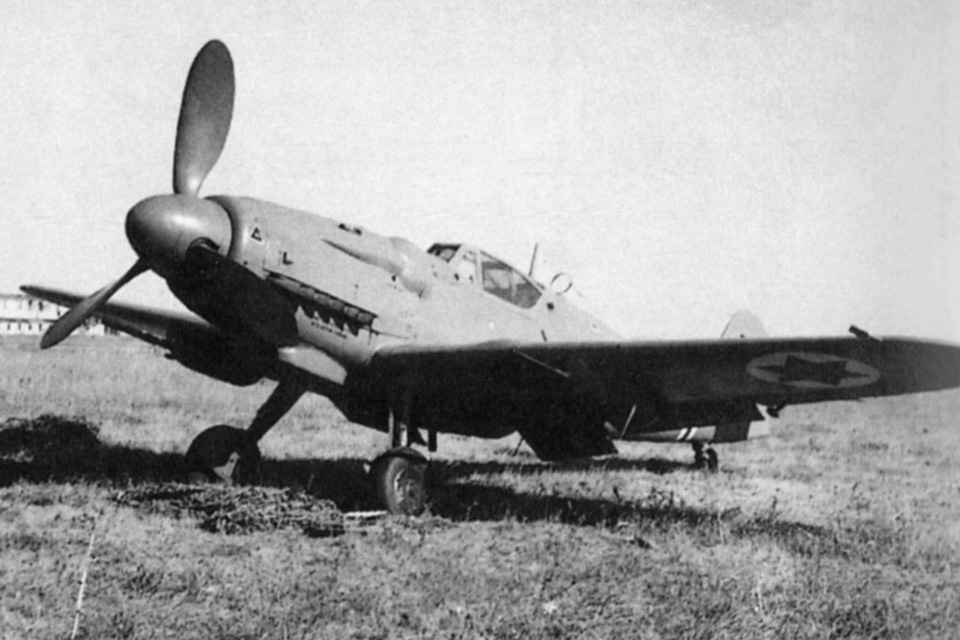
The Israelis dubbed their first fighter the Sakin (“knife”), but most of the pilots regarded its unofficial Czech sobriquet as more appropriate. Lou Lenart, a former U.S. Marine Vought F4U Corsair veteran of the Pacific War, described the S-199 as “probably the worst airplane that I have ever had the misfortune to fly…you had that monstrous propeller and you had a torque and no rudder trim.”
Nevertheless, the Sakins were rushed to Tel-Nof Air Base near Tel Aviv, and on May 29, Lenart led Allon, Weizmann and South African volunteer Edward Cohen on a bombing and strafing attack against some 10,000 Egyptian troops advancing on Tel Aviv. The Sakins inflicted some damage, but Eddie Cohen was shot down.
When two converted Douglas C-47s of the Royal Egyptian Air Force (REAF) tried to bomb Israeli headquarters at Ramat-Gan outside Tel Aviv on June 3, Allon scrambled up to intercept and shot down both. Ironically, the first recorded aerial victories for the Chel Ha’Avir (Israel Defense Force/Air Force, or IDF/AF) were scored in a postwar variation of a German fighter design. A total of seven victories were claimed in S-199s, including one of the Me-109’s traditional adversaries, a Spitfire, by Allon on July 18. The last ace to fly a Messerschmitt variant was Rudolf Augarten, a Jewish American who had scored his first two victories–both Me-109s–in World War II while flying P-47Ds with the 406th Fighter Squadron. Augarten was flying S-199 serial No. D-121 when he downed an REAF Spitfire on October 16, on the same day that Modi Allon, the most successful Sakin pilot, fatally crashed near Hertzeliya. Rudy Augarten later downed three more Egyptian aircraft while flying Spitfires and P-51Ds.
A total of 25 S-199s served in the IDF/AF, of which three were destroyed by groundfire and eight wrecked or damaged in crashes. By May 1949, Israel had acquired enough Spitfires to render the Sakins unnecessary, and by the end of the year all but one of them had been relegated to the scrap heap. The survivor served as a “gate guardian” at Hatzerim Air Base until April 1988, when it was rescued for restoration and given the status it deserved as an historical relic of the IDF/AF’s desperate formative years.
The Me-109’s long operational career ended where it had begun–in Spain. The last HA-1112-MIL emerged from Hispano’s Seville plant in late 1956, and the Spanish Messerschmitts soldiered on into the 1960s.
Although Allied bombing made it difficult to calculate an exact figure, it has been estimated that as many as 33,000 Me-109s of all models were built, making it second only to the Soviet Ilyushin Il-2 Shturmovik as the most mass-produced warplane in history. Moreover, the ubiquitous Me-109 was credited with shooting down more enemy aircraft and producing more aces than any single fighter in the annals of aerial warfare. Although not the most aesthetically pleasing airplane ever built, the Messerschmitt earned its place among the aviation classics–and, if not affection, at least respect.
For further reading, Aviation History research director Jon Guttman recommends: Warplanes of the Third Reich, by William Green; and Messerschmitt Bf-109 at War, by Armand van Ishoven.
This feature originally appeared in the May 1999 issue of Aviation History. Subscribe today!

